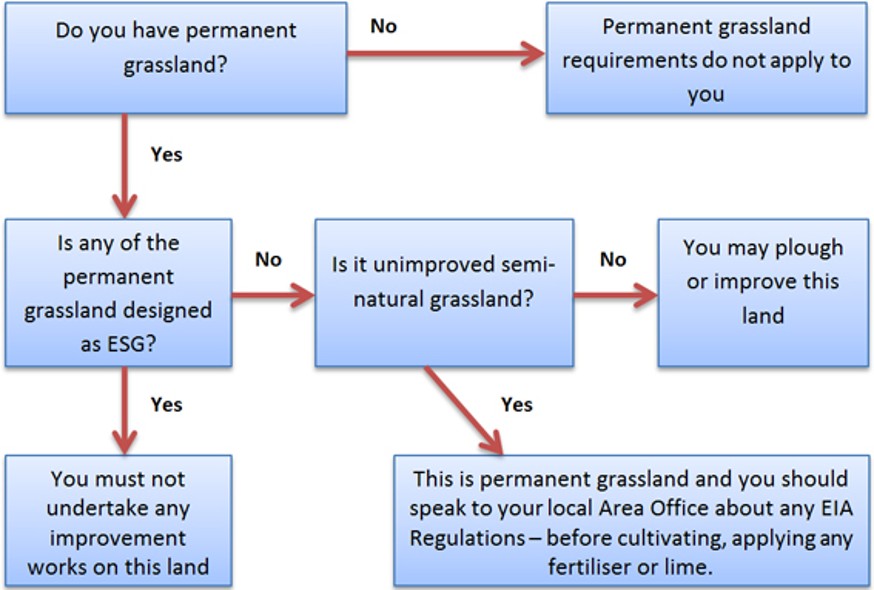Permanent grassland
This is an old version of the page
This is an old version of the page
Date published: 15 October, 2015
Date superseded: 18 February, 2016
What is permanent grassland
Permanent grassland is land used to grow grasses or other herbaceous forage (see Annex H), either naturally (self-seeded including ‘rough grazing’) or through cultivation (sown), and which is more than five years old.
All unimproved semi-natural areas are already protected by:
These grasslands cannot be improved without first determining whether an Environmental Impact Assessment (EIA) is required.
All farmers, including those farming organic land, are required to comply with Environmental Impact Assessment and Cross Compliance rules regarding ploughing of permanent grassland. If you have land in Sites of Special Scientific Interest (SSSIs), you must also observe site requirements that may apply to grassland habitats on the site.
If you want more information about this you should contact your local area office.

Pictures above: examples of permanent grassland
Greening requirements for permanent grassland
- Scotland’s requirement for Greening:
From 2015 onwards, the regulations require that the ratio of permanent grassland compared to the total agricultural area declared must not decrease by more than five per cent. The maintenance of this ratio will be monitored at a national level and it is only if there is a reduction in the ratio the Scottish Government will take action to increase the area of permanent grassland.
- your additional business requirement for Greening:
Individual businesses must not convert or plough permanent grassland designated as Environmentally Sensitive Grassland (ESG) on their holding. In Scotland, Environmentally Sensitive Grasslands have been defined as NATURA designated sites where land managers will already be bound by the existing specific management agreements in place to ensure they are protected and managed sympathetically.
You can check the ESG on your holding using the mapping tool available through logging in to Rural Payments and Services.

Pictures above: examples of environmentally sensitive grassland
What permanent grassland requirements apply to me?
Use our flowchart below to see what applies to you.

|
Helpful tips for Permanent Grassland • permanent grassland is grassland more than five years old • if your permanent grassland is designated (e.g. SSSI, SAC, SPA) in any way you should always consult Scottish Natural Heritage before carrying out any works • if you cultivate permanent grassland to establish any other crop apart from grass, the land will convert to arable and future grass will be temporary (for at least five years) • if you cultivate permanent grass and immediately sow a new grass ley, the land will retain its status as permanent grass • if you use some of your permanent grassland area as EFA, i.e. a buffer strip or field margin, this means that this area of EFA on your permanent grassland is now classed as arable land. You will declare it as Permanent Cover (PC) on your Single Application Form and it will be added to your Greening total arable area calculation. An example would be: Total area of holding = 125 ha Total arable area = 100 ha EFA is 5% = 5 ha If all the five hectares of EFA is sited on permanent grassland this would now become arable and would be added to give your new total arable area, for the purpose of Greening. Therefore: (original total arable area) 100 ha + 5 ha (EFA) = 105 ha (new total arable area). New area of EFA required is now 5.25 ha. |
What is temporary grassland?
Temporary grassland is land that has been in grass or other herbaceous forage for five years or less.
How to claim your new grassland
There are four traditional ways of establishing a temporary grassland sward:
- example one: spring sown (prior to 15 May). This is the main crop for that year and will be claimed as temporary grass, for example ‘TGRS1’ on the Single Application Form
- example two: undersown grass where the main cereal nurse crop, for example ‘SB’ will be claimed on the Single Application Form
- example three: autumn sown grass where the previous arable crop, for example ‘SO’ will be claimed on the Single Application Form
- example four: permanent grassland cultivated post 15 May and sown out to a brassica crop and then sown to grass the following Spring
If the land remains in grass for a number of years following establishment, it should be entered on the Single Application Form as follows:
| SAF | SAF | SAF | SAF | SAF | SAF | SAF | |
|---|---|---|---|---|---|---|---|
| Example one | TGRS1 | TGRS2 | TGRS3 | TGRS4 | TGRS5 | PGRS | PGRS |
| Example two | SB | TGRS1 | TGRS2 | TGRS3 | TGRS4 | TGRS5 | PGRS |
| Example three | SO | TGRS1 | TGRS2 | TGRS3 | TGRS4 | TGRS5 | PGRS |
| Example four | PGRS | TGRS1 | TGRS2 | TGRS3 | TGRS4 | TGRS5 | PGRS |
Your arable land includes any temporary grassland in your crop rotation. Temporary grassland is grass that is five years old or less.
Download guidance
Click 'Download this page' to create a printable version of this guidance you can save or print out.
